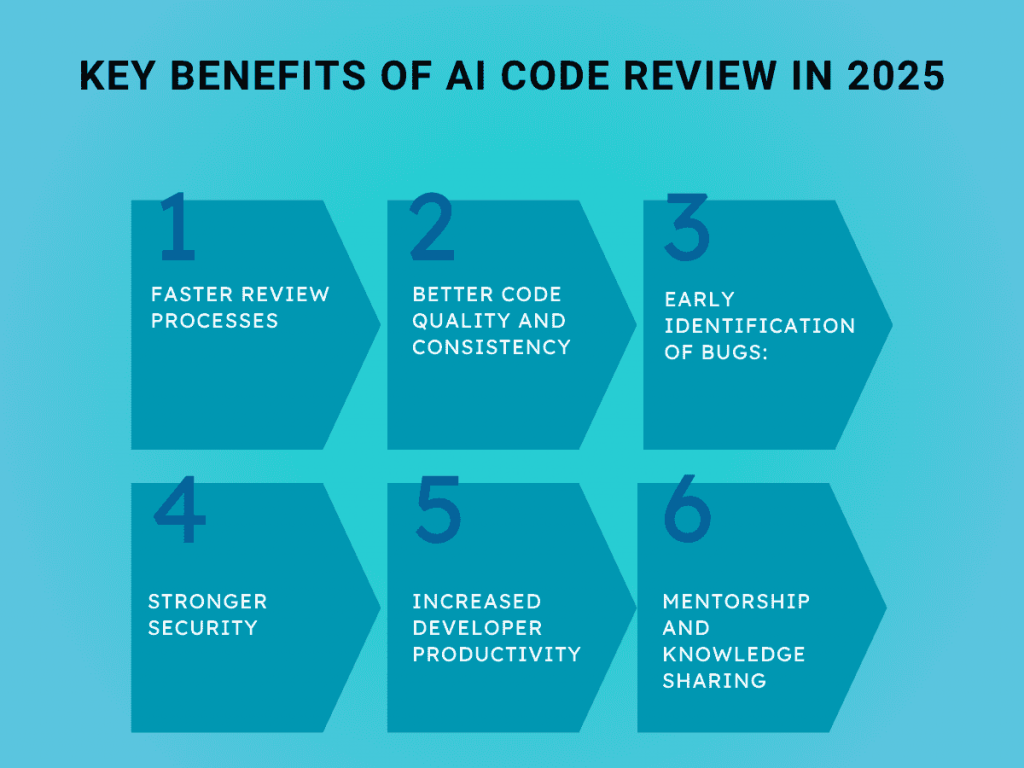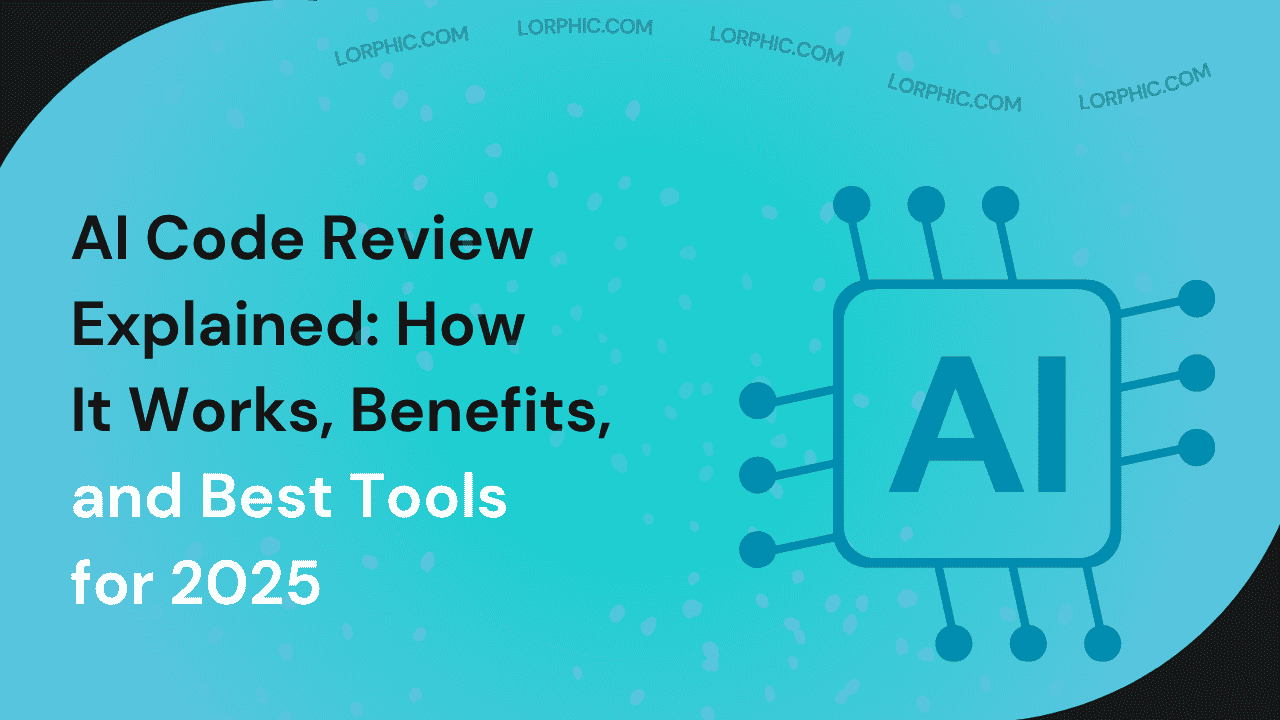The world of software development is fast changing, and at its helm stands artificial intelligence. From automating mundane and repetitive tasks to helping improve code quality, AI is fast finding a place as an essential tool among developers. Among many uses, AI code review is coming out to be a game-changing factor in the maintenance of high-quality code, catching bugs earlier, and improving productivity.
Below, we go into depth regarding what AI code review is, how it works, its benefits and limitations, the best tools in 2025, and how to integrate this practice into your workflow.
What is AI Code Review?
AI code review is the process of using artificial intelligence and machine learning to examine source code automatically. Unlike traditional code reviews, which rely entirely on human effort, AI-assisted code reviews use intelligent algorithms to detect potential problems, recommend improvements, and enhance overall code quality.
This technology does much more than simply check for syntax errors. It can uncover complex issues such as logical mistakes, security risks, repeated code, performance bottlenecks, and even whether code follows established best practices. By learning from extensive datasets and analyzing coding patterns, AI tools help developers maintain consistency and high standards across different projects.
Think of AI code review as a smart assistant for developers. It provides instant feedback, identifies possible issues before they escalate, and frees developers from routine checks so they can concentrate on more critical and strategic parts of their work.
How Does AI Code Review Works?
To understand how AI code review functions, it is important to look at the processes that allow machines to analyze and evaluate code intelligently. Here is a detailed breakdown:
Data Training and Learning
AI models learn by studying extensive datasets that include open-source projects, coding standards, and records of previous bugs and fixes. This training helps the AI recognize coding patterns, logical structures, syntax rules, and common mistakes. The more comprehensive the training data, the better the AI becomes at spotting issues and providing meaningful recommendations.
Code Parsing and Analysis
When integrated into a developer’s workflow, AI tools examine code line by line. They go beyond checking syntax and develop a deeper understanding of how the code functions and interacts with other components. This semantic understanding allows the AI to evaluate the code more intelligently.
Pattern Detection and Suggestions
AI systems rely on pattern recognition to detect inefficiencies, potential errors, and coding pitfalls. For example, they can identify repeated code, security risks, or improper use of variables. Based on these findings, the AI provides actionable suggestions to improve the overall quality and performance of the code.
Continuous Learning
Modern AI code review tools are designed to learn from developer feedback. When suggestions are accepted or rejected, the AI system uses this input to refine its recommendations over time. This continuous learning ensures that the guidance becomes more accurate and relevant with each review.
Integration with Development Tools
AI code review tools are often compatible with popular development environments, version control platforms such as GitHub, and automated deployment pipelines. This integration allows developers to receive real-time feedback during coding, pull requests, or deployment processes, making AI a valuable part of everyday software development practices.
Key Benefits of AI Code Review in 2025
AI code review tools are becoming increasingly popular because they offer significant advantages for development teams. AI code review tools are helping development teams achieve faster code reviews and more consistent quality. According to IBM, AI can automate repetitive tasks, detect errors early, and ensure code adheres to best practices, ultimately boosting developer productivity and software reliability. Here are the main benefits you can expect:

Faster Review Processes: AI can analyze large amounts of code in a fraction of the time it takes a human reviewer. This speed helps teams complete reviews quickly, accelerate development, and meet project deadlines more efficiently.
Better Code Quality and Consistency: By spotting inconsistencies and enforcing coding standards, AI ensures that your code remains clean and maintainable. It helps developers follow best practices, which reduces technical debt and keeps projects organized.
Early Identification of Bugs: AI has the ability to detect potential errors before they become serious issues. By analyzing coding patterns and predicting likely problems, it minimizes the risk of critical bugs reaching production.
Stronger Security: AI can identify vulnerabilities such as SQL injection threats, cross-site scripting risks, and unsafe API usage. This proactive approach strengthens application security and reduces the chances of breaches.
Increased Developer Productivity: By automating routine tasks like syntax checks, code formatting, and basic bug detection, AI allows developers to focus on more challenging and creative aspects of their work.
Mentorship and Knowledge Sharing: AI code review tools can guide junior developers by suggesting best practices and improvements. Over time, this helps teams learn and grow, reducing the need for constant supervision from senior developers.
Challenges of AI Code Review
| Challenge | Explanation |
| Context Understanding | AI may struggle to fully grasp project-specific logic, business requirements, or design intentions. This can sometimes result in suggestions that are not relevant or even inaccurate. |
| Reliance on Training Data | The accuracy of AI depends heavily on the quality of the data it was trained on. If the training datasets are incomplete or biased, the AI may miss important issues or flag false positives. |
| Overdependence on Automation | While AI is powerful, developers should not blindly trust its recommendations. Human oversight is essential, especially when making critical code decisions. |
| Integration Complexity | Introducing AI code review tools into existing workflows can be challenging, particularly for large or older codebases. Proper planning is needed to ensure smooth adoption. |
| Cost Factors | Advanced AI tools can come with subscription or licensing costs, which may be a barrier for smaller teams or startups. Budget considerations should be weighed before implementation. |
Best AI Code Review Tools in 2025
In 2025, several AI-powered code review tools are transforming the way developers work by improving efficiency, accuracy, and security. Here are some of the top tools that are making an impact in modern development practices.
- GitHub Copilot Reviews offers AI-powered assistance directly within GitHub pull requests. It helps developers understand code changes, summarize updates, and suggest potential fixes.
- CodeRabbit provides conversational, context-aware feedback on pull requests, making it a popular choice for teams working heavily on GitHub.
- Snyk Code AI focuses on security, helping developers identify and resolve vulnerabilities to keep applications safe and reliable.
- DeepSource Autofix combines static code analysis with AI intelligence, not only highlighting issues but also offering automatic suggestions and patches for faster fixes.
- CodiumAI specializes in reviewing the logic of code while generating thorough test cases, helping ensure functionality and reliability.
- Amazon CodeWhisperer is ideal for projects involving AWS services, providing intelligent code suggestions along with security recommendations tailored to cloud environments.
- Codeium is a lightweight AI reviewer that supports multiple programming languages, making it a practical choice for developers working on diverse projects.
- Aider is designed with privacy in mind, offering local, privacy-friendly code reviews for developers who prioritize keeping their code secure and private.
- DeepDocs ensures that code documentation stays consistent with the actual code, acting as a reliable AI assistant for maintaining accurate project documentation.
- ReviewPad combines AI-driven feedback with automation for pull requests, streamlining workflows and helping teams standardize review processes efficiently.
How to Integrate AI Code Review into Your Workflow?
Adding AI code review to your workflow can make your development process faster and more reliable if done thoughtfully. Here are some practical steps:
Choose the Right Tools
Pick AI tools that work well with the programming languages, frameworks, and development environments your team uses.
Connect to Your Development Pipeline
Set up AI reviews to run automatically during pull requests, builds, and deployment. This ensures issues are caught early.
Balance AI and Human Reviews
Let AI handle routine checks and speed up reviews, but always have humans verify design decisions and project-specific logic.
Give Feedback to the AI
Accept, reject, or adjust AI suggestions so the system can learn and provide better recommendations over time.
Track Results
Keep an eye on key metrics such as how many bugs are caught, how much time is saved, and overall improvements in code quality.
Train Your Team
Make sure developers understand how to use AI suggestions effectively and are aware of the tool’s limitations.
Conclusion
AI code review is no longer just a futuristic idea. It has become a practical tool that helps modern software teams work faster and smarter. By automating routine tasks, improving the quality of code, enhancing security, and making developers more productive, AI is becoming an essential part of software development in 2025.
Although AI cannot completely replace human judgment, combining its capabilities with the expertise of developers creates an effective workflow. The key is to choose tools that fit your team, integrate them thoughtfully into your process, and balance automation with human oversight. This approach ensures faster development, fewer errors, and higher-quality software.
FAQ’s
What is AI code review and how does it work?
AI code review is the automated analysis of source code using machine learning. It detects bugs, inefficiencies, and security vulnerabilities while providing real-time suggestions. It works by parsing code, recognizing patterns, and learning from large datasets to recommend improvements.
Can AI replace human code review completely?
No, AI complements human reviews rather than replacing them. Human oversight is essential for understanding complex logic, design decisions, and project-specific requirements.
What are the benefits of using AI code review tools?
Key benefits include faster review cycles, improved code quality, early bug detection, enhanced security, increased productivity, and knowledge sharing for team development.
How can I integrate AI code review into my workflow?
Integrate AI tools into CI/CD pipelines, combine AI with human review, monitor performance metrics, and provide feedback to continuously refine AI suggestions.
Curated by Lorphic
Digital intelligence. Clarity. Truth.




